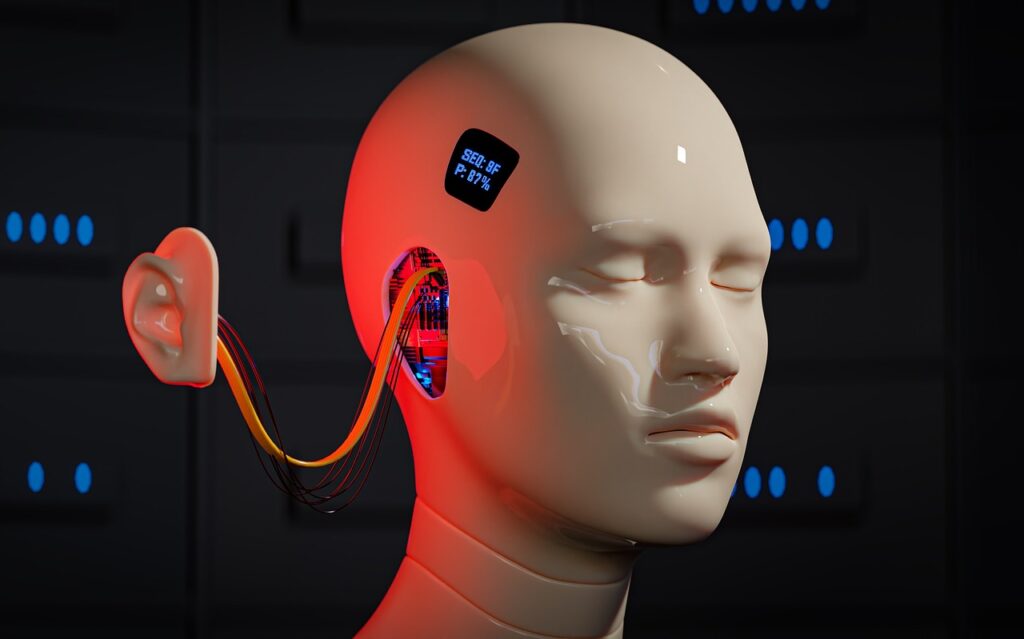Will Speech-to-Text Apps Ever Replace Human Transcription?
Speech-to-text apps are often used on the go by busy individuals to make notes, send messages, or translate simple words into other languages. In recent years these apps have made significant strides in terms of accuracy and efficiency, but there are several reasons why they should never actually replace traditional transcription services.
In this article, we’ll delve deeper into the differences between speech-to-text apps and professional human transcription services to see which comes out on top.
Speech-to-Text Apps
For a long time, the supreme goal of speech recognition technology has been to design the perfect computerised ‘listening ear’. Many science fiction movies and TV programmes over the years have shown characters talking to a computer or a robot as naturally as speaking to another human being. In these fictional scenarios, the artificial intelligence built into those machines fully understands what’s being said. It then either carries out those instructions perfectly or displays the speech on screen without any errors.
In the last few decades, speech recognition has moved beyond the realms of science fiction and is becoming more of a reality, and there are now apps designed to work on smartphones and tablet devices to turn spoken audio into text. They can be a useful live dictation tool because as you speak, you’ll see the results on your screen almost immediately. Your dictated words can be used for a text or email message, reference notes, or just for keeping a record of your thoughts and ideas at any particular time.
How Do Speech-to-Text Apps Work?
These apps use software to ‘listen’ to your audio and interpret what’s being said using speech-recognition technology, which involves several complicated steps. The sound waves from your voice are first converted into digital data and then the app attempts to remove what it considers to be any ambient sounds or background noises. Next, it breaks the data down into smaller segments so that the app can compare each segment to a bank of known words and sentences, after which point the software will display what it ‘thinks’ the recording says. Although this sounds like a lengthy and complicated process, a speech-to-text app can convert a short sentence from voice to text in mere seconds.
While this is great for short messages and dictations, with speech lasting longer than about a minute the downside is a lack of guaranteed accuracy. Short dictations can be quickly checked as you speak, but longer speech will take time for you to check through it. You’ll need to listen to the recording and at the same time read through what the app thought you said so that you can make sure everything was correctly recognised. If an app is not entirely sure what a particular word or phrase is, it will simply resort to a ‘best guess’ from its bank of words, which may well be quite different to what was spoken.
Although some advanced apps have a feature where you can train them to understand your voice, only a few claim to achieve 99% accuracy (but do not guarantee it). However, these apps will struggle to recognise more than one voice at a time, and if there’s any background noise at all then this will result in an even lower accuracy.
In many industries, accurate dictation is essential. For example, a lawyer may be dictating an email or letter about a case, or an on-site surveyor is recording important measurements and detailed instructions that need to be acted upon. If a speech-to-text app has been used, this will inevitably incur additional time to read through and correct any inaccuracies. More often than not, busy individuals such as these – and yourself – do not have that time to spare!
Professional Transcription
Now consider an experienced human transcriber, whose daily job is to listen to many diverse recordings and produce accurate, formatted transcripts according to the client’s requirements. Such a professional is very well trained in distinguishing between and identifying different speakers, understanding various regional accents and sayings, and being aware of brand names, acronyms and jargon relevant to many different industries and fields of study. These experts will take the audio or video file from a recorded dictation, conversation, meeting, conference, or any other source containing spoken content, and faithfully transcribe what has been said and by whom.
After carefully checking through their transcript and passing it on to an experienced quality control team, any words that are still uncertain (due to either poor sound quality or unfamiliarity with names, etc.) can be marked with a timestamp for you to quickly navigate to them and confirm the correct spelling.
A text-to-speech application will not notify you when it’s uncertain about something – you’ll have to spot this yourself or experience possible embarrassment if you send it on unchecked and someone else discovers an incorrect name, word or phrase.
However, when using a proven and reputable professional transcription service, you can be confident that your spoken content has been transcribed and presented correctly. Some well-established transcription companies do not just claim at least 99% accuracy – they guarantee it!
Some key factors to consider
When choosing between using a free or cheap speech-to-text app and making use of a professional transcription service, some important aspects of transcription need to be taken into consideration:
Contextual Understanding
While speech-to-text technology has certainly improved, it will often still struggle with understanding context, especially in complex discussions or when industry-specific jargon is used. Human transcribers can understand nuances, sarcasm, and the overall context much better than any app can, ensuring a more accurate transcription. Additionally, regional sayings and slang terms may be lost or misinterpreted by an app, whereas an experienced human transcriber will be aware of these terms and present them correctly. For real examples of how speech-to-text apps can change the meaning, please read our blog Lost in Translation: Examples of AI transcript blunders that will leave you giggling!
Speaker Identification
In recordings with multiple speakers, speech-to-text apps often find it challenging to differentiate between voices, and overlap occurs frequently with these apps, where parts of speech are attributed to a previous or following speaker. This results in extended editing time required to listen through and separate the text so that speech is correctly assigned to the relevant speaker. With professional transcription services that use human transcribers, speakers are more accurately identified and speech is attributed to the correct speaker.
Accents and Dialects
Speech-recognition technology has improved in understanding various accents and dialects but still falls short of handling a wide range with high accuracy. Experienced human transcribers can readily adapt to, and understand, diverse accents and speech patterns, resulting in a much more accurate transcription.
Editing and Formatting
Traditional transcription services often provide not just the text of what was spoken but also a fully edited document, formatted according to a client’s specific requirements. While some speech-to-text applications offer basic editing tools, which require the client to amend, these cannot match the level of customisation and refinement that an experienced human transcriber can provide.
Confidentiality and Privacy
Individuals, businesses and organisations might prefer professional transcription services for sensitive or confidential content due to concerns over privacy and data security with online speech-to-text applications. This is because you will not know who has access to the recordings that you upload to their servers. With reputable professional transcription services, the human transcribers are required to sign confidentiality and non-disclosure agreements to keep client data private and secure. In addition to this, professional human transcribers must adhere to the General Data Protection Regulation, ensure that their computers meet stringent security requirements, and have an up-to-date DBS certificate for clients that need this extra level of security.
Audio Quality Issues
Speech-to-text apps require particularly high-quality audio to function accurately. Interference – such as background noise, poor recording equipment, overlapping speech or breaks in the audio signal – can significantly degrade the performance of these apps. A speech-to-text app will usually provide a ‘best guess’ (which can sometimes be a garbled mess of nonsense) or simply leave out speech that it cannot understand, leaving you potentially unaware that anything is missing. Professional human transcribers are generally much more adept at working with less-than-ideal audio conditions and can identify and make a note of where such interferences occur. This additional information keeps you well-informed and fully aware of any issues in the original recording.
Complexity and Nuance
Human language is filled with nuances, including emotional cues, implied meanings, and non-verbal communication signals. The tone in which a person is speaking can dramatically change the meaning. Take for example the expression, ‘Oh, I feel great.’ Just reading that statement will make you believe the speaker is well. However, if they’re saying it in a sarcastic tone then this can mean the complete opposite. A speech-to-text app may well capture the words, but a transcript is also about capturing the meaning, and these subtleties are completely lost with current technology. Professional human transcribers, however, are experienced in recognising how a tone or emotion can convey different meanings to the words spoken. These occasions can be marked appropriately so that the transcript faithfully represents the full meaning of what was said.
Conclusion
For a small number of applications, such as with very short recordings where accuracy is not critical, speech-to-text technology offers a quick and cost-effective solution. However, for business or official purposes, or in any other instances where accuracy is important, professional human transcription services are still the champions of transcription and will remain indispensable for the foreseeable future.
At McGowan Transcriptions we provide high-quality, accurate transcriptions to a wide variety of individuals, businesses, organisations and government bodies. Our skilled professional team understands how vital accuracy is to you, and your transcription will go through rigorous checks to ensure it’s 100% correct before it’s sent on to you. We’ve been transcribing since 1993, so you can be sure we have the experience, expertise and technology to provide you with the most accurate transcriptions possible for you or your business or organisation. If you would like to know more, please get in touch with the team today.
Call 0800 158 3747 or email office@mcgowantranscriptions.co.uk
April 2024
 GET A QUOTE
GET A QUOTE ORDER ONLINE
ORDER ONLINE





